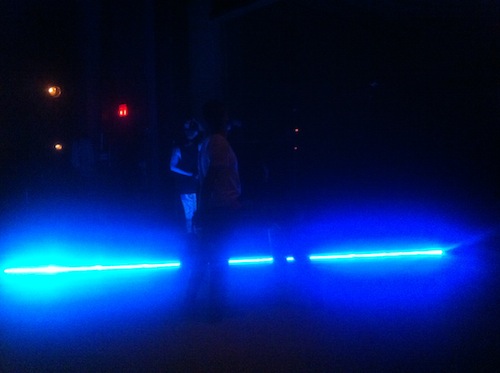
Carlos Maria Romero & Juan Betancurth. “Carlos Maria Romero, Juan Betancurth, David González Jiménez. 27.07.2013. New York. Abrons Arts Center. 19:00. Names of all spectators separated by comma,” 2013. Live performance. Photo: Martin Camacho.
It was the year 2002 and the middle of winter in New York City. I was walking through Chelsea with an eclectic group of friends—a couple of noise musicians, sculptors, and a British avant-pop-cabaret maestro in a red velvet smoking jacket. The leader of our pack turned the corner at Ninth Avenue and opened the door to the bar and nightclub L.U.R.E. (Leather. Uniform. Rubber. Etc.) We were there to check out PORK, a weekly performance art event.
All I had really known of kink/BDSM performance was Bob Flanagan’s Supermasochist. And even though I had been thinking about relationships between pain and pleasure, sex and performance, domination and submission upon our visit to L.U.R.E., the scene brought me to a new level of consciousness.
Videos of men fisting played on screens throughout the club. Slings, harnesses, chains, straps, cuffs, and collars moved in unison with the precision of a synchronized swimming competition, but this set resembled a gym or maybe a boxing ring. Five to ten guys lined up to dispense and receive pain and pleasure in equal turns. Chains clinked together and leather straps sung against flesh. Grunting, crying, and cursing echoed throughout the bar. Along the back wall, live performances took place in cages, where men flaunted various parts of their anatomy. At times, a big guy would enter the cages to rough the men up, smacking, beating, and berating them though occasionally offering tender comments and caresses. My friends and I were awed, terrified, and curious.
Carlos Maria Romero & Juan Betancurth. “Carlos Maria Romero, Juan Betancurth, David González Jiménez. 27.07.2013. New York. Abrons Arts Center. 19:00. Names of all spectators separated by comma,” 2013. Live performance. Photo: Martin Camacho.
Fast-forward to last month’s Festival TBD: Emergency Glitter at Abrons Arts Center, where L.U.R.E came to mind during Carlos Maria Romero, Juan Betancurth, David González Jiménez. 27.07.2013. New York. Abrons Art Center. 19:00. Names of all spectators separated by commas, a collaborative performance by choreographer Carlos Maria Romero and visual artist Juan Betancurth. Part nightclub, theater, warehouse, and wood-shop, the performance turned Abron’s Playhouse space into a discursive site where bodies, objects, words, and smoke performed with equal resonance.
Carlos Maria Romero & Juan Betancurth. “Carlos Maria Romero, Juan Betancurth, David González Jiménez. 27.07.2013. New York. Abrons Arts Center. 19:00. Names of all spectators separated by comma,” 2013. Live performance. Photo: Martin Camacho.
After a walking tour through the back stairwell of the theater, the audience sat on stage with the artists. As the performance began, the artists posed against electric glamour—neon, fur, leather, lights, and a large mirror. Betancurth sat on a rocking horse with a muzzle. Romero stood. As the lights grew brighter and the bass of the music grew deeper, the tableau intensified but quickly descended into the mundane. The audience was asked to help Romero roll and then unroll Marley dance flooring to no consequence.
Carlos Maria Romero & Juan Betancurth. “Carlos Maria Romero, Juan Betancurth, David González Jiménez. 27.07.2013. New York. Abrons Arts Center. 19:00. Names of all spectators separated by comma,” 2013. Live performance. Photo: Martin Camacho.
An extended period of darkness ensued while Betancurth maneuvered the hardware, tools, and mechanisms of the theater in the midst of lights and smoke. Romero quietly recited excerpts from philosophical books on labor, describing “emotional work” as separate from “productive,” “immaterial,” and “empty” work. It sounded like a mash up of Michel de Montaigne and social anthropology. Betancurth presented objects of his making: sex toys with extra masochistic qualities that insinuated real pain. Various sorts of pinchers and grabbers with sharp points, an animal brush with what looked like a mace on one side, and a pony tail butt plug with weights attached were passed around the audience like a show and tell. The garage door at the back of the theater opened to the sound of thudding techno music and revealed a carpentry shop; its vices, hammers, and slop-sinks began to take on a sexual flavor. The audience was given entry into a world where sex, power, language, mediocrity, labor, and fantasy bumped up against each other, stood in for one another, or came awkwardly together like bodies that cruise through clubs and industrial spaces in search of pleasure or punishment.
Carlos Maria Romero & Juan Betancurth. “Carlos Maria Romero, Juan Betancurth, David González Jiménez. 27.07.2013. New York. Abrons Arts Center. 19:00. Names of all spectators separated by comma,” 2013. Live performance. Photo: Martin Camacho.
What reminded me of L.U.R.E. was the clanking sounds of chains, metal rings, and tubing. And also the permission I felt I’d been granted to be a spectator—being a voyeur and not knowing whether the scene before me was meant for me. The banality of those acts didn’t seem to need me as a witness, but Romero and Betancurth inspired me to think about performance as a type of prosthetic, an extension of the body that serves to connect it to an experience, task, or action that it cannot produce on its own.
Carlos Maria Romero & Juan Betancurth. “Carlos Maria Romero, Juan Betancurth, David González Jiménez. 27.07.2013. New York. Abrons Arts Center. 19:00. Names of all spectators separated by comma,” 2013. Live performance. Photo: Martin Camacho.
This idea of the prosthetic then reminded me of Samuel R. Delany’s book Times Square Red Times Square Blue in which he argues for a “community of contact,” where connections across lines of class, race, gender, and ability take precedent over social networking, status climbing, and homogenous relationships where like attracts like. For me, what was important about L.U.R.E as an institution (it closed in 2003) and live performance in general are the very real opportunities for contact that only such communal spaces can offer.
